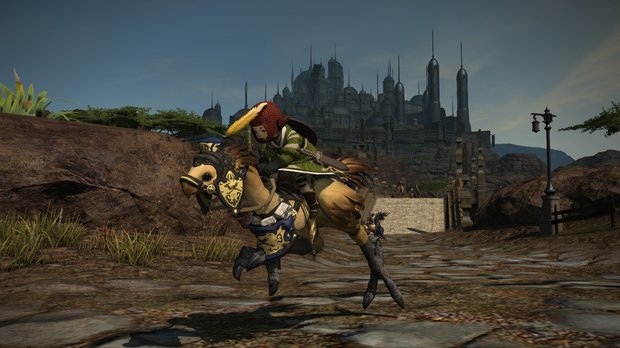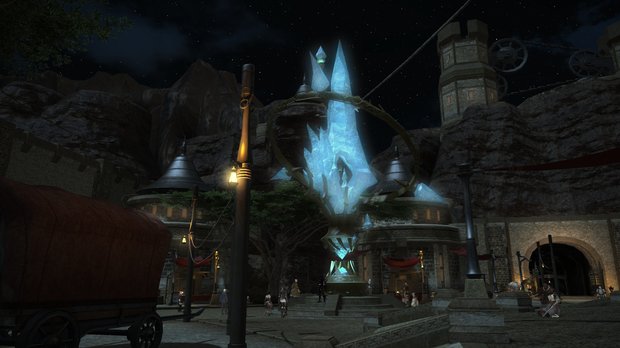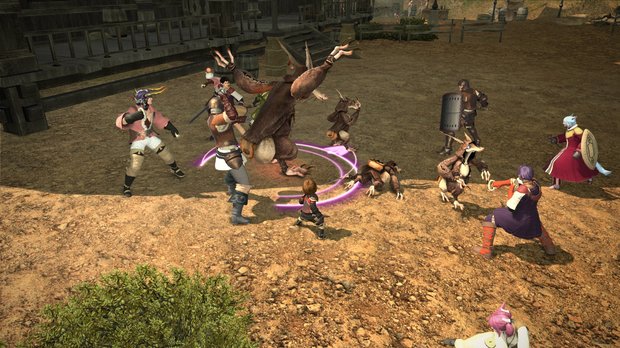Why Final Fantasy 14 failed (and how it was reborn)
“Running an MMORPG is like running a country,” says Naoki Yoshida, director and producer of Final Fantasy 14: A Realm Reborn. He's giving a presentation during 2014's Game Developers Conference, discussing why the original FF14 failed, and how his team rebuilt it from the ground up, transforming it into significantly better MMO it is today. He motions to a PowerPoint presentation adjacent to his podium; one of its bullet points suggests that if a dev team can be thought of as a country's government, then the players are its citizens. Yoshida continues, "The biggest coup de grace is to uninstall the game and leave." If that's true, the original Final Fantasy 14 had its capital pillaged and burnt to the ground.
When FF14 launched back in 2010, it was met with a terrible player response and equally terrible media reviews. To quote our own: "As you wade ever deeper, you discover a swampy muck of bugs, quirks, and design decisions that stroll right up to common sense, retch loudly, and then spit in its face." We're not exactly talking about material for Rolling Stone's Feel Good Hit of the Summer here. Take a look at the game's staggeringly low 49 Metacritic score and you'll find all sorts of complaints about unstable servers, a nightmarish user interface, and awful quest design among others. In short, Final Fantasy 14 was a disaster, and it suffered a worst case-scenario fate: termination.

Immediately after FF14's initial launch, Yoshida was brought on to restructure the development team and rebuild the game from scratch. He succeeded (more on that later), and much has been said about how great A Realm Reborn is. What's not been said, however, is how Square Enix originally created such a junky MMO for one of its most important franchises. How did the company fail to see that its Next Big Thing suffered from mortal wounds? And once it had no choice but to look, how did it then proceed with releasing that game into the wild? The answer, according to Yoshida, was hubris.
See, Square Enix had experienced eight long years of success with its first MMO, 2003's Final Fantasy 11--so much so that it wanted to replicate that accomplishment by making a new MMO for a new generation of gaming hardware. But great success, Yoshida said, can breed great failure. When designing FF14, Square Enix succumbed to the pressures of having to succeed a second time. Yoshida points to three primary reasons for FF14's failure.

First: an unhealthy obsession with graphical quality. During his GDC presentation, he pulled up an image of a flower pot that appeared in the game. It's something a player might walk past without ever paying attention to; yet that flower pot had 1,000 polygons--the same number of resources that went into each player character. Because the in-game assets were of such high quality, the original FF14 had to be broken up into small instanced settings to prevent hardware from suffering a nuclear meltdown. Only a handful of players could ever be present in the same playing field at once, which, Yoshida said, went completely against the inherent social qualities of MMOs in the first place.
Second, Yoshida cited the development team's surprising lack of MMORPG knowledge as a huge contributor to FF14's failure. MMOs aren't very popular in Japan, as PC gaming is practically non-existent. The only way for these types of games to succeed in that region is if they're available on a console, as FF11 was on the PS2. As such, many of the developers' only MMO experience was with FF11, and they were unaware of the significant changes introduced to the genre since 2003.
Finally, Square Enix had adopted a mindset that any problem could be fixed in the future with a patch. Not only did this make for a significantly unstable launch (FF14 suffered hundreds of daily crashes in addition to its underlying design problems), but this thought process was used as a crutch for the game's structural flaws.
Weekly digests, tales from the communities you love, and more

With all these issues built into FF14's foundation, it was doomed from the start. Unfortunately, Square Enix didn't see it coming. "The original FF14 being a failure had such a big impact, a negative impact, it shocked the community and shocked everyone in general," Yoshida said. "There was a sense of danger--that if FF14 doesn't regain itself, Square Enix and the Final Fantasy brand is at risk."
At 4 a.m. on November 27, 2010, Yoshida--who had been working for years as a director on Square Enix's Dragon Quest franchise--received an email requesting that he act as both the director and producer of FF14 to relaunch the game. The hope was that, by doing so, Square Enix could repair the damage and mistrust that FF14 had caused. The tricky part: not only did Yoshida and his team have to rebuild the game from scratch (surprise! Its structure was too flawed to implement changes via patches), but they had a little more than two years to do it. Yoshida sad that's about half the development cycle typically allotted to a game of this scope.

He began by interviewing the development staff of the original FF14. "I couldn't get a straight answer of what kind of game they had wanted to make," he said, "and so we needed to start from there. We wanted to establish what kind of gameplay experience we wanted to provide to our fans." He then had to ensure the development staff were up to the task. "I made sure to weed out the people that didn't believe in FF14, and people who thought there was no saving FF14. There's no point in having people, even if they're so skilled, if they don't believe in the title."
Once his team was on the same page, Yoshida faced another problem: He couldn't transition everyone to work full time on developing A Realm Reborn because he had to simultaneously maintain service on a drowning FF14. "A Realm Reborn's design and settings were done with a smaller scale team, including myself and just a few members of the development team," he said. "The larger team was instructed to follow suit with my designs, but keep keep up with the old FF14, to keep that running. When it came to designing the other content and things that go into the actual game, that's when we started taking the larger development staff and we gradually did that process." On December 31, 2012, service for the original FF14 was terminated, allowing all of Yoshida's development team to shift their focus to A Realm Reborn.

On August 27, 2013, A Realm Reborn was released to the public. This time, FF14--the newly rebuilt FF14--was viewed not as a metaphorical trainwreck, but as an immensely enjoyable MMO that captured the spirit of the Final Fantasy franchise. "After the game had relaunched, the media reviewed it very well, and the fans were very happy, we had such positive feedback." Yoshida said. For him, the relief was overwhelming. "There were parts in which I felt that no one could understand the pressure that I was feeling--it's not that i'm asking for people to empathize, but I'd been working throughout the night while people were asleep, and there was that feeling of solitude, of loneliness, and I'm sitting there thinking to myself, 'why am I doing this?' That was definitely a challenge. I'm sure a lot of people were very skeptical about relaunching a game, but I was really happy that all the staff of the company joined with me in full force. We all believed in this game happening."
Near the end of his GDC presentation, Yoshida pulled up one final slide, entitled: "What we have learned." Its bullet point lessons were the exact opposites of the mindset that went into building the original FF14:
1. Never forget the fans. Without them, there would be no 'us'
2. Fun comes first. If it isn't fun, you're doing it wrong
3. Never back down. Always aim to amaze
4. Don't forget your roots. It's what fans crave
"Breaking a promise is the worst thing that you can ever do, and I promised the people that I would make this game happen," Yoshida said. "The fact I was able to deliver on that promise is a great relief."
Ryan was once the Executive Editor of GamesRadar, before moving into the world of games development. He worked as a Brand Manager at EA, and then at Bethesda Softworks, before moving to 2K. He briefly went back to EA and is now the Director of Global Marketing Strategy at 2K.



